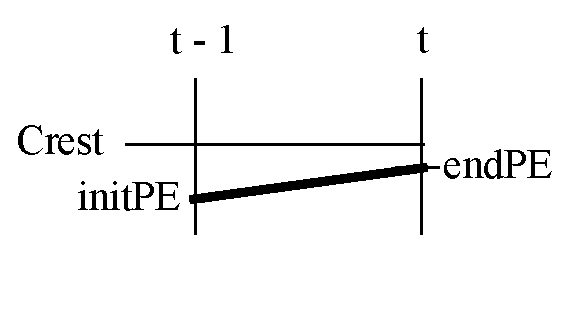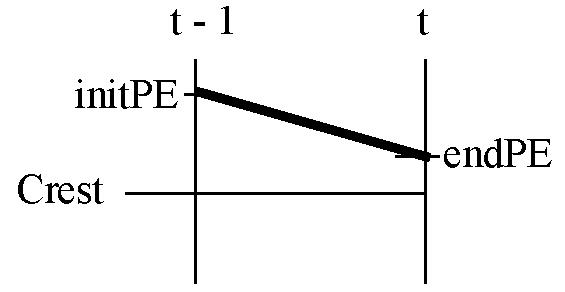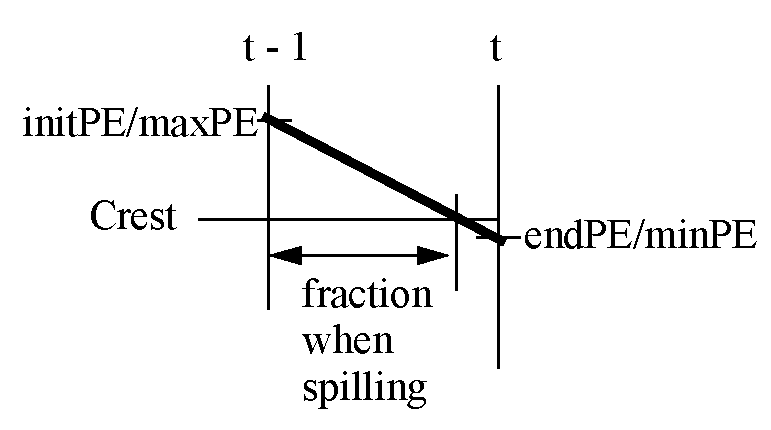Unregulated Spill Type
This category is only visible when a method using Unregulated Spill is chosen. The methods in this category do the actual computations for computing the unregulated spill.
The Bare Crest Only method is the default method in the Unregulated Spill Type Category. The method assumes an unobstructed spillway where the flow over the spillway is a function of the Unregulated Spill Table.
There are no slots specific to this method.
Computing Bare Crest Unregulated Spill
1. A temporary variable called initHW is created to represent the Pool Elevation at the beginning of the timestep. Likewise, endHW is created to represent the Pool Elevation at the end of the timestep. If the Pool Elevation at the end of the timestep is not known, endHW is set equal to the Pool Elevation at the beginning of the timestep.
2. The Unregulated Spillway Crest is found on the Unregulated Spill Table by searching for the Pool Elevation that corresponds to a Spill of zero
3. If both initHW and endHW are less than or equal to the Unregulated Spillway Crest, Unregulated Spill is set equal to zero.
4. If both initHW and endHW are greater than or equal the Unregulated Spillway Crest, the average Pool Elevation is used to determine the Unregulated Spill from the Unregulated Spill Table.

5. If either initHW or endHW is greater than the Unregulated Spillway Crest and the other is lower than the crest, the following evaluations and computations are performed:




That is, spill fraction corresponds to the fraction of the timestep during which spill occurs.
A temporary variable called “temp spill” is obtained from the linear interpolation of the Unregulated Spill Table using avgHW. Unregulated Spill is then calculated as follows:

The Unregulated Spill is then limited to be less than or equal to the maxUnregulatedSpill if one has been calculated. See below.
Computing the Maximum Possible Unregulated Spill
If an unregulated spill method is called from the Solve given Inflow, Release dispatch method, getMinSpillGivenInflowRelease or solveTurbineRelGivenEnergyInflow RPL predefined functions, there is an upper limit on the unregulated spill. The upper limit prevents the unregulated spill from dropping the reservoir below the crest.
Note: Use the Bare Crest, Table Only method described in Bare Crest, Table Onlyif you do not want to use this maximum. The maximum may not apply for reservoirs with little storage compared to the inflows and outflows.
The following algorithm is performed at the start of the following methods to compute this maximum unregulated spill (maxUnregulatedSpill):
• Solve given Inflow, Release dispatch method (Storage and Level Power reservoirs)
• Solve given Inflow, Outflow dispatch method (Storage and Level Power reservoirs)
• GetMinSpillGivenInflowRelease RPL predefined function
• SolveTurbineRelGivenEnergyInflow RPL predefined function
1. Given previous Storage and Pool Elevation (initPE), all known inflows (Inflow, Hydrologic Inflow, Precipitation, Return Flow, etc) and known outflows (Release, Regulated Spill, Bypass, Evaporation, Diversion, etc) are used to compute the storage and pool elevation (endPE) that would occur with no additional unregulated spill.
2. If both initPE and endPE are less than or equal to the Unregulated Spillway Crest, maxUnregulatedSpill is set to zero and the computation exits. There is no way there could be unregulated spill. See Figure 29.4.
Figure 29.4 Diagram showing both initPE and endPE below the crest

3. If both initPE and endPE are greater than or equal to the Unregulated Spillway Crest, the maxUnregulatedSpill is computed as the flow that would draw the reservoir down to exactly reach the crest at the end of the timestep. This computation solves the reservoir mass balance and includes all source and sink terms. All water above the crest could be spilled. See Figure 29.5.
Figure 29.5 Diagram showing both initPE and endPE above the crest

4. If either initPE or endPE is greater than the Unregulated Spillway Crest and the other is lower than the crest (because of existing Diversions, Evap, etc), the following evaluations and computations are performed (see Figure 29.6.)



That is, spill fraction corresponds to the fraction of the timestep during which spill occurs.
Figure 29.6 Diagram showing the PE crossing the spillway crest during the timestep

5. The storage at the crest, crestStorage, is computed from the Elevation Volume Table.
6. The storage, maxStorage, that corresponds to the maxPE is found on the Elevation Volume Table.
7. The maxUnregulatedSpill (limited to be greater than or equal to zero) is then computed as follows:

The maxUnregulatedSpill is applied as a final limit on the Unregulated Spill. Remember, the Unregulated Spill is computed as described in the start of this method using the Unregulated Spill Table and a similar spill fraction approach; it may already be less than the maxUnregulatedSpill.
The Bare Crest, Table Only method behaves like the Bare Crest Only method, but does not perform the calculations described in Computing the Maximum Possible Unregulated Spill. The unregulated spill is set to the value computed based on the bare crest algorithm and table values, without the volumetric check for volume above the crest. Use this method for reservoirs with little storage compared to the inflows and outflows.
The method assumes an unobstructed spillway where the flow over the spillway is a function of the Unregulated Spill Table.
There are no slots specific to this method.
Computing Unregulated Spill
1. A temporary variable called “initHW” is created to represent the Pool Elevation at the beginning of the timestep. Likewise, “endHW” is created to represent the Pool Elevation at the end of the timestep (If the Pool Elevation at the end of the timestep is not known, endHW is set equal to the Pool Elevation at the beginning of the timestep.)
2. The Unregulated Spillway Crest is found on the Unregulated Spill Table by searching for the Pool Elevation that corresponds to a Spill of zero
3. If both initHW and endHW are less than or equal to the Unregulated Spillway Crest, Unregulated Spill is set equal to zero.
4. If both initHW and endHW are greater than or equal the Unregulated Spillway Crest, the average Pool Elevation is used to determine the Unregulated Spill from the Unregulated Spill Table.

5. If either initHW or endHW is greater than the Unregulated Spillway Crest and the other is lower than the crest, the following evaluations and computations are performed:




That is, spill fraction corresponds to the fraction of the timestep during which spill occurs.
A temporary variable called “temp spill” is obtained from the linear interpolation of the Unregulated Spill Table using avgHW. Unregulated Spill is then calculated as follows:

When the Two Unregulated Flows method is selected, flow over the spillway is a function of the Unreg Flow 2 Spill Table. If the pool elevation meets or exceeds the Unreg Flow 2 Failure Elevation, flow becomes a function of the Unregulated Spill Table.
Note: This method was originally named “Flashboards” but was renamed to be more general. Flashboards are wooden boards installed in the unregulated spillway so the reservoir can store more water than what the spillways themselves would allow.
Slots Specific to This Method
Unreg Flow 2 Avail and Failure Time
Type: Agg Series Slot
Units: Fraction
Description: Availability of Unreg Flow 2 Spill Table, fraction of timestep when Unreg Flow 2 Spill Table is in use.
Information:
I/O: Optional: Availability may be input by user or set by a rule. Failure time is output only
Links: Not linkable
Unreg Flow 2 Failure Elevation
Type: Table Slot
Units: Length
Description: Pool Elevation at which Unreg Flow 2 Spill Table is no longer used.
Information:
I/O: Required input
Links: Not linkable
Unreg Flow 2 Spill Table
Type: Table Slot
Units: Length vs Flow
Description: Pool Elevation vs corresponding unregulated flow 2 spill values.
Information: Must contain a row which corresponds to a spill of zero for interpolation purposes.
I/O: Required input
Links: Not linkable
Method Details
To determine the spill tables to use during a timestep based on availability of Unreg Flow 2, the following possibilities are checked.
1. Availability is input or set by a rule: no change from Unreg Flow 2 to Unregulated Spill over timestep, calculate spill based on availability.
2. Availability is 0: no change from Unreg Flow 2 to Unregulated Spill, calculate spill based on Unregulated Spill Table.
3. Availability is greater than 0, check if failure from Unreg Flow 2 to Unregulated Spill occurs during the timestep.
During the third case, the spill over the timestep is calculated using the respective table and multiplied by the availability to find the total spill over the timestep. The total spill is used to predict the pool elevation at the end of the timestep. The calculated pool elevation is compared to the Unreg Flow 2 Failure Elevation. If a failure from Unreg Flow 2 to Unregulated Spill is found to occur any time during the timestep, the failure time is recorded and the ending pool elevation is re-calculated to account for the change in spill due to the change from Unreg Flow 2 to Unregulated Spill during the timestep.
Note: If a failure from Unreg Flow 2 to Unregulated Spill occurs during a dispatch, the first time of this failure is used for the remainder of the dispatch.
The time of failure during the timestep is used to determine what portion of the timestep needs interpolation from each of the two spill tables. The unregulated spill is the sum of the two unregulated spills.
When the Three Unregulated Flows is selected, flow over the spillway is a function of the Unreg Flow 3 Spill Table. If the pool elevation meets or exceeds the Unreg Flow 3 Failure Elevation, flow becomes a function of the Unreg Flow 2 Spill Table. If the pool elevation meets or exceeds the Unreg Flow 2 Failure Elevation, flow becomes a function of the Unreg Flow Spill Table. To summarize, Unreg Flow 3 fails first, then Unreg Flow 2 fails next as the pool rises. Therefore, the Unreg Flow 2 Failure Elevation should be higher than the Unreg Flow 3 Failure Elevation.
Note: This method was originally called the Flashboards and Superboards method but was renamed to be more general. Flashboards and superboards are wooden boards installed in the unregulated spillway so that the reservoir may store more water than what the spillways themselves would allow. The superboards can only be installed if the flashboards are in place.
Slots Specific to This Method
Unreg Flow Avail and Failure Time
Type: Agg Series Slot
Units: Fraction
Description: Availability and failure time of Unreg Flow 2 and Unreg Flow 3 Spill tables.
Information:
I/O: Optional: Availability may be input by user or set by a rule. Failure time is output only
Links: Not linkable
Unreg Flow 3 Failure Elevation
Type: Table Slot
Units: Length
Description: Pool Elevation at which Unreg Flow 3 Spill Table is no longer used.
Information: The value in this slot should be lower than the value in the Unreg Flow 2 Failure Elevation.
I/O: Required input
Links: Not linkable
Unreg Flow 3 Spill Table
Type: Table Slot
Units: Length vs Flow
Description: Pool Elevation vs corresponding unregulated flow 3 spill values.
Information: Must contain a row which corresponds to a spill of zero for interpolation purposes.
I/O: Required input
Links: Not linkable
Unreg Flow 2 Failure Elevation
Type: Table Slot
Units: Length
Description: Pool Elevation at which Unreg Flow 2 Spill Table is no longer used.
Information: The value in this slot should be higher than the value in the Unreg Flow 2 Failure Elevation.
I/O: Required input
Links: Not linkable
Unreg Flow 2 Spill Table
Type: Table Slot
Units: Length vs Flow
Description: Pool Elevation vs corresponding unregulated flow 2 spill values.
Information: Must contain a row which corresponds to a spill of zero for interpolation purposes.
I/O: Required input
Links: Not linkable
Method Details
To determine the spill tables to use during a timestep based on availability of Unreg Spill 2 and Unreg Spill 3, the following possibilities are checked.
1. Both availabilities are input or set by a rule: no change in unregulated spill type over timestep, calculate spill based on availability.
2. One availability is input or set by a rule: Error, both or none must be input.
3. Availabilities are 0. No change in unregulated spill type over timestep. Calculate spill based on Unregulated Spill Table.
4. At least one availability is greater than 0, check for failure in unregulated spill type.
During the fourth case the spill over the timestep is calculated using the respective table and multiplied by the availability to find the total spill over the timestep. The total spill is used to project the pool elevation at the end of the timestep. The calculated pool elevation is compared to the failure elevations of Unreg Flow 2 or Unreg Flow 3. If failure in unregulated spill type is found to occur any time during the timestep, this failure time is recorded and the ending pool elevation is recalculated to account for the change in spill due to the change in unregulated spill type during the timestep.
Note: If a change in unregulated spill type occurs during a dispatch, the first time of this change is used for the remainder of the dispatch.
The time at which change in unregulated spill type occurred during the timestep is used to determine what portion of the timestep needs interpolation from each of the three spill tables. The unregulated spill is the sum of the three unregulated spills.
Revised: 06/04/2022